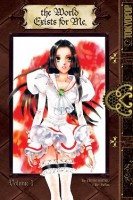My News and Reviews
Last week I posted the first review in my new monthly review project, A Year of Yuri. This project will focus on comics and manga with yuri and lesbian themes. For this month’s review, I took a closer look at June Kim’s debut graphic novel 12 Days which was even better than I remembered it being. It’s a beautiful work that addresses the complexities of grief, family, love, and loss.
Also last week, I wrote a post that focused on how to find manga in libraries—Finding Manga: Library Love. The post is sort of a combination of two of my semi-regular features—Finding Manga and Library Love. (I’ve actually decided to retire Library Love, so the post was also a way for me to give the feature a nice send-off.) It’s a pretty long post; if you don’t feel like reading the whole thing, you can always just skip to the quick tips at the end.
As for interesting things found online: The Pew Research Center coincidentally posted its report on How Americans Value Public Libraries in Their Communities the same day I was expressing my own love of libraries; over at Geekscape, Kari Lane discussed yaoi with Jennifer LeBlanc, SuBLime’s editor; and Erica Friedman talked about some of the differences between the U.S. and Japanese comic book industries on Quora.
Quick Takes
 Fake Fur by Satomi Yamagata. For a boys’ love manga, Fake Fur is surprisingly realistic in its portrayal of Yamashita—a young man who in high school is just starting to come to terms with his sexuality and homosexuality. The manga follows him as he becomes aware that he is in love with his close friend Kubo and how he handles the aftermath of that realization and his changing relationships. Fake Fur deals with both physical and romantic desire and how those two aspects of love can often be in conflict with each other. In some cases, sex and physical pleasure is used as a replacement for true affection. For Yamashita and several of the other characters in Fake Fur, this is something that is both comforting and heartbreaking. On the other hand, for better or for worse, physical intimacy can naturally lead to emotional intimacy. After all, a sexual relationship is still a relationship. In Fake Fur Yamashita and the others grapple with this, hoping to find love but also recognizing that there is more than one way to be close to another person.
Fake Fur by Satomi Yamagata. For a boys’ love manga, Fake Fur is surprisingly realistic in its portrayal of Yamashita—a young man who in high school is just starting to come to terms with his sexuality and homosexuality. The manga follows him as he becomes aware that he is in love with his close friend Kubo and how he handles the aftermath of that realization and his changing relationships. Fake Fur deals with both physical and romantic desire and how those two aspects of love can often be in conflict with each other. In some cases, sex and physical pleasure is used as a replacement for true affection. For Yamashita and several of the other characters in Fake Fur, this is something that is both comforting and heartbreaking. On the other hand, for better or for worse, physical intimacy can naturally lead to emotional intimacy. After all, a sexual relationship is still a relationship. In Fake Fur Yamashita and the others grapple with this, hoping to find love but also recognizing that there is more than one way to be close to another person.
 Sankarea: Undying Love, Volume 4 by Mitsuru Hattori. The covers for the English-language edition of the Sankarea manga tend to focus on the horror elements of the series. While that horror is certainly a part of Sankarea, I still see it as more of a romantic comedy than anything else. Granted, it is a very strange romantic comedy with even stranger characters. I like the series best when it’s focusing on the relationship between Chihiro and the recently zombified Rea, which has some interesting developments in this volume. For one, Rea continues to become more zombie-like, her cravings for flesh barely being held in check by her natural inhibitions. However, I was less impressed with the mostly unnecessary scene between Chihiro and Rea’s mother in which she drunkenly and nakedly propositions him. Apparently the volume’s fanservice quota needed to be met somehow. My favorite part of this volume was actually the side-comic “I Am Also…A Zombie…” which is told from the perspective of Chihiro’s pet cat (and zombie) Bub. Bub is the greatest.
Sankarea: Undying Love, Volume 4 by Mitsuru Hattori. The covers for the English-language edition of the Sankarea manga tend to focus on the horror elements of the series. While that horror is certainly a part of Sankarea, I still see it as more of a romantic comedy than anything else. Granted, it is a very strange romantic comedy with even stranger characters. I like the series best when it’s focusing on the relationship between Chihiro and the recently zombified Rea, which has some interesting developments in this volume. For one, Rea continues to become more zombie-like, her cravings for flesh barely being held in check by her natural inhibitions. However, I was less impressed with the mostly unnecessary scene between Chihiro and Rea’s mother in which she drunkenly and nakedly propositions him. Apparently the volume’s fanservice quota needed to be met somehow. My favorite part of this volume was actually the side-comic “I Am Also…A Zombie…” which is told from the perspective of Chihiro’s pet cat (and zombie) Bub. Bub is the greatest.
 Showa: A History of Japan, 1926-1939 by Shigeru Mizuki. Originally published in Japan as an eight-volume series, Drawn & Quarterly’s edition of Showa: A History of Japan is being released in four, two-volume omnibuses. Japan’s Showa era, corresponding to Emperor Hirohito’s reign, lasted from December 25, 1926 to January 7, 1989. In the introduction to the first volume of Showa, Frederik L Schodt describes the Showa era as one of “the most tumultuous, violent, and tragic” periods in Japan’s history. There are actually two intertwining stories contained in Mizuki’s Showa: the factual history of the country as a whole at that time and Mizuki’s personal history as someone who lived through it. Mizuki’s artwork also reflects these two different portrayals of the Showa era. The illustrations range from the highly detailed and realistic, based on news and photographs from that period, to the more free-form and cartoonish. Showa is an informative read. I’m personally more familiar with the late Showa era, so I appreciated being able to learn more about early Showa in such an engaging format.
Showa: A History of Japan, 1926-1939 by Shigeru Mizuki. Originally published in Japan as an eight-volume series, Drawn & Quarterly’s edition of Showa: A History of Japan is being released in four, two-volume omnibuses. Japan’s Showa era, corresponding to Emperor Hirohito’s reign, lasted from December 25, 1926 to January 7, 1989. In the introduction to the first volume of Showa, Frederik L Schodt describes the Showa era as one of “the most tumultuous, violent, and tragic” periods in Japan’s history. There are actually two intertwining stories contained in Mizuki’s Showa: the factual history of the country as a whole at that time and Mizuki’s personal history as someone who lived through it. Mizuki’s artwork also reflects these two different portrayals of the Showa era. The illustrations range from the highly detailed and realistic, based on news and photographs from that period, to the more free-form and cartoonish. Showa is an informative read. I’m personally more familiar with the late Showa era, so I appreciated being able to learn more about early Showa in such an engaging format.
 The World Exists for Me, Volumes 1-2 written by Be-Papas and illustrated by Chiho Saito. The literal translation of the Japanese title for The World Exists for Me would actually be The World of S and M. Though I’m sure it was intentionally chosen, it’s a rather peculiar title for a rather peculiar manga. Only two volumes were ever published, but I get the feeling that The World Exists for Me was originally conceived of as a much longer work. The ending comes very suddenly and very little, if anything, is actually resolved. The series definitely had some potential—I found its use of time travel, destiny, and historical figures and events to be interesting—but the story never quite pulls together as something particularly coherent. It’s a bit of a mess, really. While it can be enjoyable, it doesn’t really make much sense at all. The World Exists for Me was developed by the same creators involved with the Revolutionary Girl Utena manga. Some similarities can be seen between the two series, but I much prefer Utena.
The World Exists for Me, Volumes 1-2 written by Be-Papas and illustrated by Chiho Saito. The literal translation of the Japanese title for The World Exists for Me would actually be The World of S and M. Though I’m sure it was intentionally chosen, it’s a rather peculiar title for a rather peculiar manga. Only two volumes were ever published, but I get the feeling that The World Exists for Me was originally conceived of as a much longer work. The ending comes very suddenly and very little, if anything, is actually resolved. The series definitely had some potential—I found its use of time travel, destiny, and historical figures and events to be interesting—but the story never quite pulls together as something particularly coherent. It’s a bit of a mess, really. While it can be enjoyable, it doesn’t really make much sense at all. The World Exists for Me was developed by the same creators involved with the Revolutionary Girl Utena manga. Some similarities can be seen between the two series, but I much prefer Utena.

For me once I realized the implications of the main character in Sankara wanting a “Zombie girlfriend” meant, I couldn’t read the series with out being able to ignore the necrophilia subtext.
Oh yeah, that necrophilia subtext is definitely a part of the series. Sometimes it’s not even subtext.
Yeah which it’s kind of hard to find it funny with that thought in the back of you’re mind, I mena I get it but also if I’m too busy being made incredibly uncomfortable by something it’s kind of hard for me to find it funny or engaging in anyway
I can definitely understand that. Sankarea is a rather odd series that certainly won’t be to everyone’s taste. (Not that anything ever is.)
Well that’s the thing I liked volume one but than after I put two and two together I’m like Alex in Colckwork Orange “You ruined it for me you ruined it” LOL